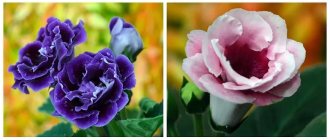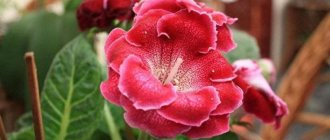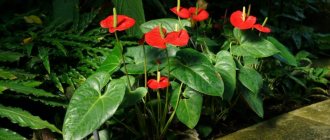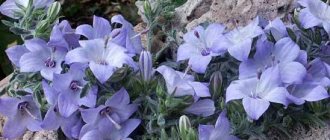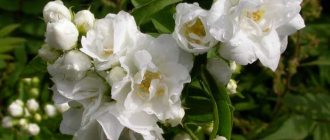Description
Campanula garden is undemanding to growing conditions and grows in a variety of places - forests, steppes, rocks and wastelands.
The flower's homeland is the Mediterranean countries; it grows well in regions with a temperate climate - in Asia, North America, and the Caucasus. The plant is herbaceous, perennial, the stem can be straight or creeping, up to 1 m long. The leaf blades on long cuttings are heart-shaped, about 7 cm long. The shape of the inflorescences is pyramidal. Flowers up to 4 cm in diameter, various shades: white, purple, blue, pink, etc.
The flowering phase begins in June and ends in September.
Campanula garden is a perennial, moisture-loving crop that requires regular watering, especially during the active growing season and flowering phase. The soil must be drained so that water does not stagnate, as the root system may rot. If you remove faded flowers from the bush in a timely manner, you can activate and stimulate the formation of new buds. In October, the stems are cut off and the root system is insulated with fallen leaves or peat.
Campanula flowering period
The flowering period begins in spring and lasts until October. The flowers are white (female plant), blue, blue and purple (male plant). The flowers are collected in delicate inflorescences - thyroid-type panicles no more than 4 cm in diameter. At the end of the flowering period, fruits - capsules - are formed on the plant.
In order to stimulate flowering in the future, it is important:
- Remove dry inflorescences in a timely manner;
- Trim branches in a timely manner;
- Grow in a cramped pot.
If you place a flower pot on a south window, the plant may bloom again in winter.
Dormancy period and pruning of campanula
The dormant period, depending on the conditions of keeping the flower, can begin from October to December.
At this time it is necessary:
- Reduce watering as much as possible to eliminate the possibility of water stagnation in the flowerpot during the cold season;
- Reduce the temperature of the bell to +12-+15 degrees (you can even place the flower pot closer to the window, so the plant will receive the required amount of light);
- Trim the shoots, leaving each no more than 10 cm long or with two or three buds.
If the campanula was kept in comfortable conditions before the dormant period, and pruning was done at the beginning of the dormant period, the plant can bloom again by the New Year holidays.
Repeated pruning is carried out in January, the stems are shortened to 5 cm.
The vast majority of dormant buds are concentrated in the lower part of the branches.
Kinds
Campanula lactiflora
Campanula lactiflora
The plant is perennial, with a branched stem about 90 cm long, light-loving. The diameter of the flower is about 3 cm, the shade is milky or lilac, the inflorescence is pyramidal.
Carpathian Campanula (Campanula carpatica)
Carpathian Campanula (Campanula carpatica)
In nature it grows on the slopes of the Carpathians and Central European calcareous rocks. Decorative, unpretentious, long-flowering frost-resistant crop. The height of the bushes is about 40 cm, the stems are mostly erect, the shoots are covered with villi, branching. The plastic sheets are green in color, slightly hairy, with veins, rounded and heart-shaped. The flowers are large, single, cup-shaped, about 5 cm in diameter, blue, white or purple in color, formed on the tops of stems and branches.
The flowering phase begins in mid-summer and ends in autumn. Used in the design of rock gardens and balconies.
Campanula persicifolia
Campanula persicifolia
The plant is up to 95 cm high, the leaf blades are similar to peach leaves, the flowering phase lasts all summer, the flowers are blue or white.
Campanula trachelium
Campanula trachelium
The stem is branched, straight, its height is about 1 m. The flowers are large, white or light purple. Blooms profusely until late summer. Leaf blades are jagged and rough.
Pozharsky's bell (Campanula poscharskyana)
Pozharsky's bell (Campanula poscharskyana)
The leaf blades are round in shape, the shoots are creeping, long, the flowers are small, up to 2.5 cm in diameter, bright lilac in color. Cold-resistant and shade-tolerant plant.
Bluebell (Campanula glomerata)
Bluebell (Campanula glomerata)
The plant is about 60 cm high, the stem is erect, sparsely bristly. The root system is fibrous, the leaf blades are alternate, smooth on top, bristly on the reverse side, elliptical in shape. The flowers are bell-shaped, blue in color, and the inflorescence is spherical. The plant is undemanding to soil conditions and frost-resistant.
Bluebell (Campanula latifolia)
Bluebell (Campanula latifolia)
It can grow up to 120 cm, the root system is well developed, growing up to 15 cm in length. The leaf blades are ovate, slightly pubescent. Lilac flowers.
Campanula medium
Campanula medium
Height up to 1 m, branching stem, basal leaf blades have a lanceolate shape, narrow sessile leaves are located on the stem. The flowers are large, up to 7 cm in diameter, located along the length of the stem. They bloom alternately, the flowering phase lasts 60 days. The shape of the flowers is bell-shaped or goblet-shaped.
Features of cultivation
When growing a plant, you need to consider several features:
- It is necessary to promptly remove dried flowers. This stimulates the formation of new buds, so flowering will be abundant;
- in October, the stems need to be cut, and then the root system should be insulated with fallen leaves and peat;
- tall varieties should be tied up so that they do not bend or break from gusts of wind;
- the bush is renewed annually by planting new cuttings;
- if the leaf blades begin to turn yellow from too bright rays, the bush must be shaded.
Selecting soil and planting location
The area should be well lit and protected from gusts of wind. The soil solution is neutral or slightly alkaline. The soil must be drained; before planting, it must be dug up and weeds removed.
Fertilizers and fertilizers
During the active growing season (spring-summer), the plant is fed with nitrogen-containing microfertilizers once every 14 days. After flowering, phosphorus-potassium fertilizers are applied.
Watering
The soil should be well moistened; it is recommended to water the garden campanula daily. In autumn, the amount of watering is reduced.
Loosening and weeding
Weeding is carried out regularly to prevent the growth of weeds that negatively affect the development of the plant. After watering, the soil needs to be loosened to provide the roots with oxygen.
Transfer
The plant does not tolerate transplantation very well. If it still needs to be done, it is best to do it at the end of August. Campanula garden should be replanted together with a ball of earth so as not to damage the root system. The prepared hole in the soil is watered with water, the plant is placed in it and sprinkled with soil.
Trimming
In the second year of life, Campanula garden forms several peduncles. This can cause depletion of the plant, so excess flower stalks are cut off. In mid-autumn, cut off the above-ground part of the bush, leaving 10-15 cm.
Wintering
The plant is pruned, the roots are insulated with fallen leaves or peat.
Campanula transplant
The process of transshipment of campanula
When choosing a pot for a bell, you should remember that this is a plant with a powerful root system that grows rapidly immediately after transplantation. That is why flower growers recommend choosing a container of at least five liters for campanula.
Replanting is necessary annually, as the root system quickly depletes the soil, which negatively affects the flowering of the bell.
The optimal time for transplantation is spring, namely March. As for the composition of the soil, the plant has no special preferences; a universal soil mixture is often used to grow campanula.
Considering that most types of campanula are short-lived plants, they do not require replanting. More often, the bell is rejuvenated by rooting cuttings.
Reproduction methods
There are the following methods for propagating garden campanula:
- dividing the bush - carried out in May or August. The plant is dug up, divided into several parts, each of which consists of an underground and above-ground part, and has growth points. Then the divisions are planted in the prepared recesses. If the size of the bush is large, small parts are cut off from it with a sharp shovel, which are then planted in the chosen place;
- cuttings - in June, cut off an annual peduncle, plant it in loose soil, and shade it. In about thirty days it will take root;
- seeds - collected when the capsule turns dark brown. The seed material is dried, sown in open soil in the fall, lightly sprinkled with soil, and watered. In spring sprouts appear. When they grow up, they are transplanted into a prepared hole in a permanent place.
Small cup volume
For rooting, the shoots are planted in small cups with a volume of no more than 50 ml. If you want to plant a white and a blue flower at the same time, then you need to make a partition between them, because the more resilient “bride” will crowd out the modest “groom”, preventing him from developing.
There is no need to think that a spacious container will allow you to quickly get a new young bush.
The shoot will stretch upward without growing in width. The roots of Campanula are thin, thread-like, they will not be able to develop the territory and absorb all the moisture. A white coating will appear on the surface, the plant will hurt and rot.
Possible problems
If you do not follow the basic rules for caring for garden campanula, some problems may arise:
- for planting you need to choose a well-lit area, otherwise the growth of the plant slows down and the stems stretch;
- the soil must be drained so that moisture does not stagnate and the roots do not rot;
- it is necessary to water the bushes in a timely manner so that the soil does not dry out and the plant does not suffer from water deficiency;
- the soil needs to be loosened, the root system needs oxygen.
How to deal with pests and diseases of Campanula
Garden perennial tradescantia - planting and care in open ground
If planting and caring for campanula in the garden is improper, the gardener may encounter the following problems:
- Powdery mildew. The leaf blade is covered with a white powder-like coating. If you look closely, you can see small ulcers from which fluid is released. The leaves begin to wither, dry out and fall off. You can get rid of powdery mildew using systemic fungicides.
- Leaf nematode. The worms settle on the leaf, where they live and feed. Then the leaf becomes covered with brown spots, curls and falls off. In the fight against parasites, the drugs “Nefamos”, “Dimethoate” or “Vidat” are used.
- Rust. This disease affects the stem and leaves. A sign of the disease is clusters of orange or brown spores on the underside of the plate, yellow oval or round spots on the top. Then the spots turn into brown stripes and the leaves fall off. The disease is eliminated with chemicals: “Topaz”, “Abiga-Pik”, “Baktofit”, “Fitosporin-S”.
Leaf infected with rust
Important! If the plants are attacked by insects, then homemade campanula must be treated with insecticides.
Campanula garden in landscape design
When decorating borders, rockeries, flower beds, and ridges, low-growing varieties are used, combining them with other flowers (for example, fern or mallow). Campanula garden looks good in the middle of a flower bed and as a carpet plant.
The plant is undemanding, responsive to care and attention paid to it. Plant several different varieties in your garden and enjoy their blooms from early summer until autumn.
Rules of care
Watering:
- in summer - every morning or evening;
- in winter - once a week.
Top dressing
- every 2 weeks from early spring to early autumn. Fertilizers are suitable for violets.
Ways to stimulate flowering:
- cut off faded flowers;
- in winter, place in a cool place, but with good lighting, reduce watering;
- In spring, pinch out young shoots.
Bush formation
. When planting, it is necessary to cut off the shoots at a height from the root: 2-3 cm





